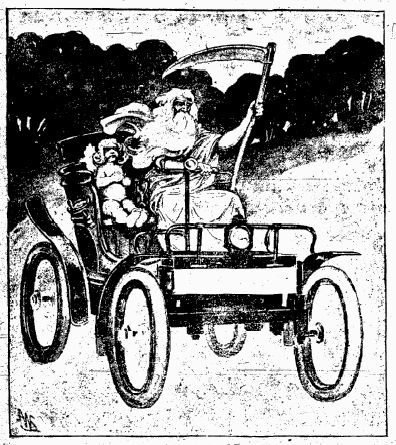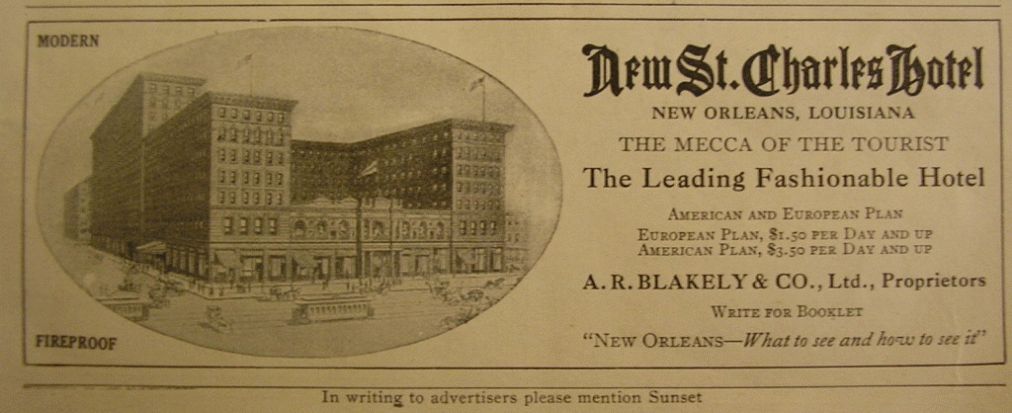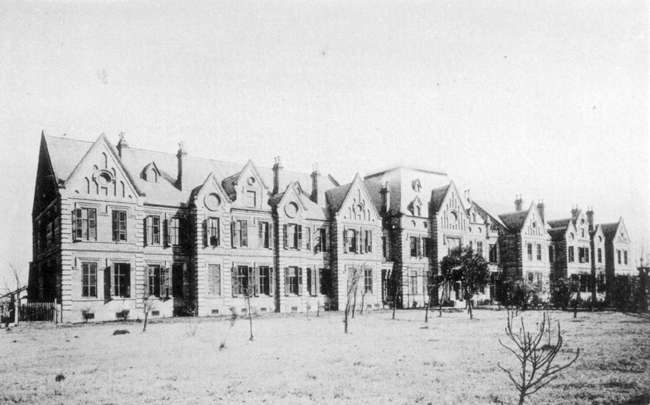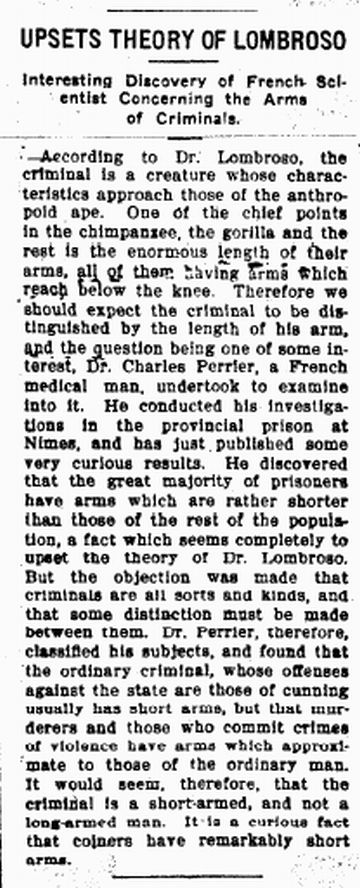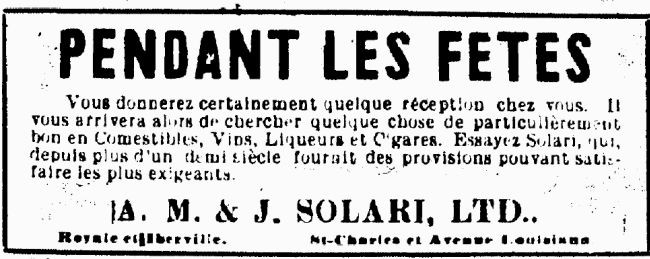|
New Orleans in the Last Century ~~ 1910 |
|
|
January |
|||||||||||
|
|
New Orleans in the Last Century – 1910 --
January On January 1, 1910 the front page of the popular eighty-three
year old French language Abeille de la Nouvelle-Orleans newspaper (known as The Bee) recapped highlights from the previous
year when the Sewerage and Water Board's Purification Plant on Earhart Boulevard first brought clean clear water to most
residents, The Parking Commission (which would become the Parkway and Park Commission) was formed, and the first lots in the
Gentilly Terrace (“Where Homes are Built on Hills”) were being sold. Plans for Public Bath No. l at
400 St. Mary Street were submitted to the City of New Orleans by Stone Brothers who had already designed the Baldwin, the
Civic, and the Greenwall Theatres, the Young Men's Hebrew Association’s Club Building and Auditorium,
the Confederate Memorial Hall, the Jackson Apartments, the Teutonia Bank Building, and the Maison Blanche building.
Ground was broken at the sight of the old post office and courthouse on Lafayette Square for
a new three story building that would house the post office on the entire first floor, the Federal District Court and Court
of Appeals on the second floor and the Executive Branch agencies on the third. It was designed by James
Gamble Rogers who would later design Newcomb Hall and Newcomb Art School on the H. Sophie Newcomb Memorial College campus.
The building was renamed the John Minor Wisdom U.S. Court of Appeals Building in 1994. The
“World’s Greatest Refinery of Sugar” – fourteen stories high and costing $6,000,000 – first
operated in Chalmette, employing 1000 men. It was the largest cane sugar refinery in the United States
capable of producing approximately 800,000 tons of refined sugar per year. Joseph Bennett, at his camera
shop on St. Charles Avenue introduced do-it-yourself photography to the city. Gertrude Willis and her husband
Clem founded an insurance company and funeral parlor. Max Scheinuk
opened a flower shop. Arthur Boh started a small residential construction company
which all New Orleanians now know as Boh Brothers. Joseph Haspel and his brothers opened a clothing store
which later introduced seersucker suits to the world. The first Zulu parade rolled in the streets of the
city. The first "telegraphone", an instrument that (at that time) permitted use of telegraph
lines for telephone purposes, had been installed by the Louisiana Railway & Navigation Company in Alexandria.
The Atlanta Constitution had reported on June 8, 1909 that the “First Car Ever Shipped Leaves for New Orleans
Market”. Joan Newton Cuneo broke speed records at the Mardi Gras auto races beating Ralph De Palma
– later that year women were banned from racing by the American Automobile Association. Theatre pianist and composer
Robert Hoffman copyrighted and published “I’m Alabama Bound” in New Orleans but Jelly Roll Morton claimed
to have written it – reclaiming it by adding lyrics and renaming it “Don’t You Leave Me Here”. The Philadelphia-New Orleans Ship Line made history when the steamship Luckenbach arrived from Philadelphia marking
the first maritime commerce between the two cities. A railroad connection first linked New Orleans to Houston
in 1909. It was from against this backdrop that New Orleanians stepped into 1910. Frederick
H. Elliot, Secretary of the American Automobile Association reported in the New York Times article, “National Benefits
for Auto Owners” on January 2 that an estimated 200,000 cars would be produced in the United States that year and noted
the “bustling activity everywhere apparent among makers of cars and accessories” which would likely increase by
up to 50% over that of the previous year as well as “the increasing popularity of the motor vehicle”
The Annual Mardi Gras Speed Carnival, hosted by the New Orleans Automobile Club and scheduled for February 4 –
6, was listed among the “Calendar of Events in the Auto World”. 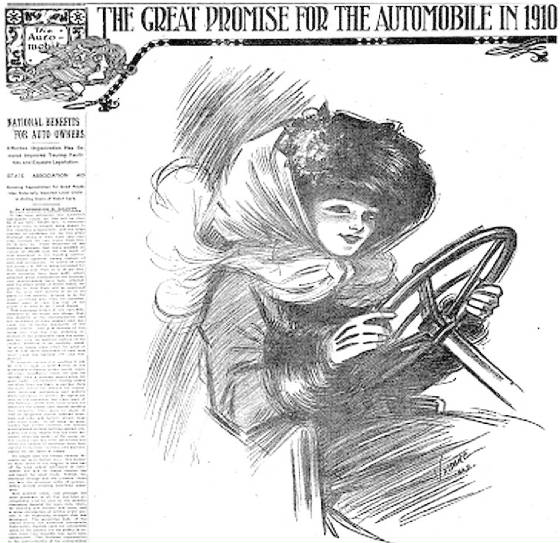 New York Times article “National Benefits for Auto Owners” by Frederick H. Elliot. January 2, 1910 Elliot’s enthusiasm for the fledgling motor vehicle industry was exemplified by Mr. And Mrs Walter H. Hanson of Saratoga Springs who, on January 4th set out from New Orleans to the Pacific Coast. This trip was so newsworthy that it was published by the Los Angeles Times in an article titled “TRAIL BLAZERS LEAVE FOR WEST. AUTOMOBILE PARTY WILL SEEK BEST DESERT ROUTE” where “Mud is the Only Obstacle Feared by Plucky Travelers”. New Orleanians had many travel options on the first day of the new year for going near or far from home. The “Ozone Route” of the New Orleans Great Northern railroad offered $1 excursions to Covington, Claiborne, Abita Springs, Ozone Park, Mandeville, Oaklawn, Bon Fouca, and North Slidell. A longer trip could be taken on the Illinois Central's Central Mississippi Valley Route to McComb or Baton Rouge for $1.50. On the Texas Pacific one could travel to the lithium laden “healing waters” of the Mineral Wells, Texas. The Frisco line also went Texas as did the Southern Pacific (on the Sunset Express) which also traveled the rails to California, Arizona, New Mexico, and Mexico. The Queen & Crescent took New Orleanians to New York, Baltimore, Philadelphia, Washington, Cincinnati, Norfolk, St. Louis, and Birmingham. Pullman Cars on the L & N New York to New Orleans, LTD. offered a luxurious ride. 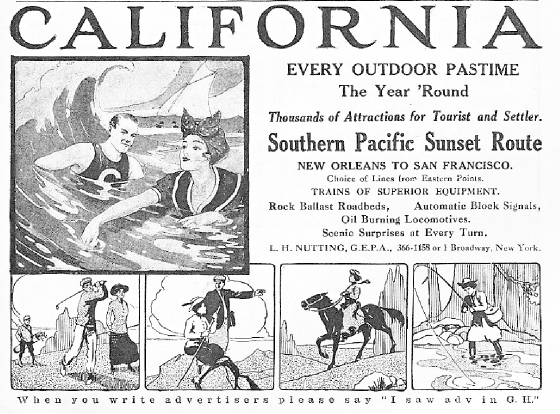
If travel was not affordable, a visit to a local theatre cost as little as ten cents. On New Year's Day of 1910 Blaney's Lyric Theatre presented A Deserted Bride”. At the Opera House, Hansel et Gretel was presented. The Tulane Theatre offered a production of The Merry Widow. The Shubert and Cresent Theaters are also listed. At the Orpheum one had many choices from Vaudeville to Kinodrome (an early version of 35 mm projected film). Thirty-four lots were for sale on January 1st in the area bounded by Clara Street, South Street, Washington
St, and. Willow Street made available due to the liquidation of the People's Brewing Company which had been located there.
Companies which were still operating on this day, with advertisements in “The Bee” the Francis & Paul Maestri
Furniture Co., the funeral services of James Bonnet, F. Laudemiey and Co. Ltd., and Emile Labat as well as the New St. Charles
Hotel.
The Touro-Shakespeare Almshouse was built with funds from the bequest of Juha P. Touro on what
is now what is now Daneel Street between Joseph Street and Nashville Avenue. Originally in the block bounded by Piety,
Desire, N. Peters and Chartres Streets, the propery transferred to the city after the Civil War. This building was demolished
in 1932 when Touro Shakespeare moved to Algiers. Photo Courtesy of the New Orleans Public
Library On January 3rd the Ancient Arabic Order of the Nobles of the Mystic Shrine snnounvrf
that the preparation of for their 36th annual session of the Imperial Council which would be hosted in April by the Jerusalem
Temple of New Orleans (whose Shrine Mosque designed by Emile Weil during the 1920s was not yet a city landmark) . The Shriners
anticipated that a convention in New Orleans would insure that “Decorations and Illuminations will be unique”. Documentary The Shriners' Pilgrimage to New Orleans (1910) ... Distributor (1910) (USA) by Selig Polyscope Company 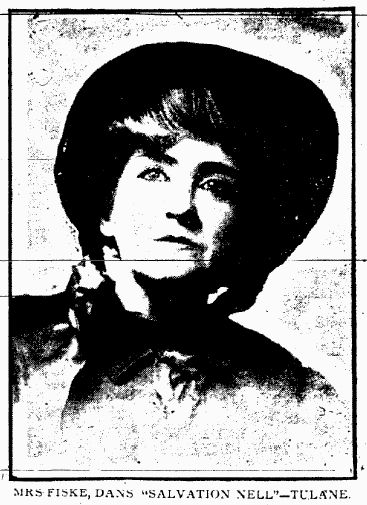 Nell Saunders was played by actress
and playwright Mrs. Minnie Maddern Fiske who was born in New Orleans in 1865. Her father, Thomas Davey,
was the manager of the St. Charles Theatre. Her mother was Lizzie Maddern, also an actress who first performed
as "Little Minnie Maddern" at the age of three. Mrs. Fiske made her New York debut in 1870. The January 5th edition
of the Chicago Tribune included an advertisement featuring “THE ONLY SOLID THROUGH TRAIN. / Chicago to New Orleans.
VIA BEAUTIFUL GULF COAST. THE "NEW ORLEANS… Write for free 70 page book about New Orleans”.
But a hard freeze on the 8th, during which a mother was discovered dead in bed by her son, may have deterred
visitors from vacationing in the Crescent City.
Crime: http://query.nytimes.com/mem/archive-free/pdf?res=9D0DE1D91730E233A25751C1A9679C946196D6CF POISONED; ACCUSED WOMAN.; Letters Found After Jeweler's Death Say... January
11, 1910, Tuesday DO NOT BELIEVE SHE POISONED
MAN Foreshadow -- Axeman from http://blogs.forteana.org/node/70 -- use much more in other months: After she killed Manfre, Mrs. Albano told authorities
that she was previously married to a grocer by the name of Michele Pepitone. On January 12, 1921, she went to Los Angeles to attend her niece’s wedding and met Albano there.
Albano had been married to Mrs.Pepitone’s sister, but she had since passed away. Four
months later he proposed and they were married on September 12th. However, an examination of the marriage licenses
and certificates of marriage for Esther Pepitone and her niece reveal a different story. The niece, Rose
Albano, seventeen at the time of her wedding, married Frank R. Cusimano, 26, on September 7, 1921, not January 12th. Esther Pepitone married Angelo Albano using the name Pasqua Pipitone
on September 2, 1921 – less than a week before the niece’s wedding. On December 26, 1910, in the final days of the Qing Dynasty for instance, the provisional national assembly decreed that all citizens should cut off the traditional long braid, or queue. On January 13, 1911, the New Orleans Times-Democrat reported that the Chinese population of New Orleans welcomed the decree because the braids were "burdensome as well as troublesome." http://historyengine.richmond.edu/episodes/view/4438
http://query.nytimes.com/gst/abstract.html?res=9F02E0DC1139E333A2575BC1A9679C946196D6CF
A Benefactor of the South
COULON DEFEATS GAME LAD
MITCHELL COMES TO NEW ORLEANS January 26, 1910 http://query.nytimes.com/gst/abstract.html?res=9E02E7D71730E233A25755C2A9679C946196D6CF
Cardinal Gibbons in New Orleans.
J.B. Solari 's Cosmopolitan Hotel at 121 Royal Street was luxurious -- four stories high
with bay windows and a hand-carved curved staircase which spiralled from the floor to the skylight. It's
cafe was considered among the best in the city. Each room was steam heated and had a private bath. On
January 28, 1910 a man fell from a shoeshine stand there and was admitted to Charity Hospital. He suffered
a fractured nose and other injuries and then developed uremia. Initially, no one knew his name. No friends visited.
He was Lewis G. Tewksbury, son of a wealthy Manchester, New Hampshire family who
landed in New York as a weathy financier, he was a "gentleman", and he was penniless. But
he had always lived the good life, often through shady buisness practices and outright theft which likely accounted for
his stay in one of New Orleans' finest hotels. When the money was good he owned a luxuirous
home in New York City furnished with finery and expensive paintings. He owned a stable of expensive horses valued at
$100,000. He owned the firm of Lewis G. Tewksbury at 32 Broadway. In 1897 he lost it all to bankruptsy with
a debt of over $1,000,000. In 1900 he the suddenly disappeared from New York, headed to London where he was
indepted for $25,000. He was charged with the theft of $10,000 in bonds stolen from his wife. In
1906 he was charged with 1st degree Grand Larceny. He fled to Mexico. And he lay near death in Charity Hospital
at the end of the first month of 1910.
Scribner's Magazine - January 1910. Midwinter Gardens of New Orleans - An Object Lesson And Its Argument by George W. Cable. President, mayor, governer, arhcbishop, etc. |
||||||||||
|
|
|||||||||||

